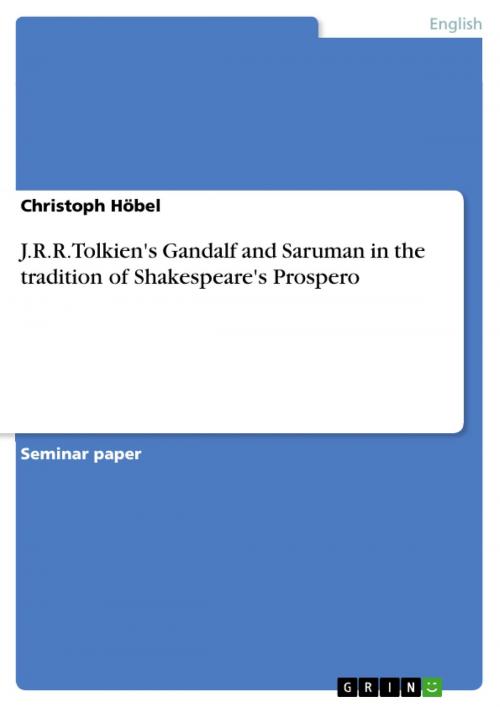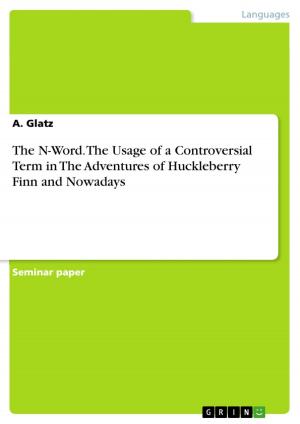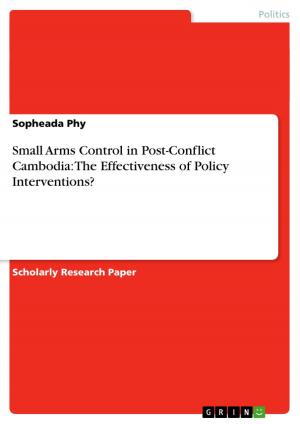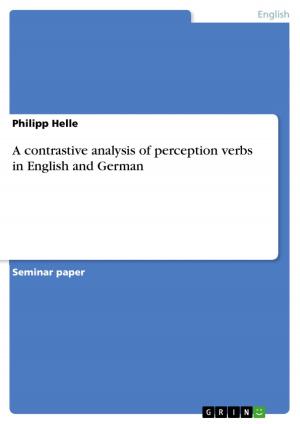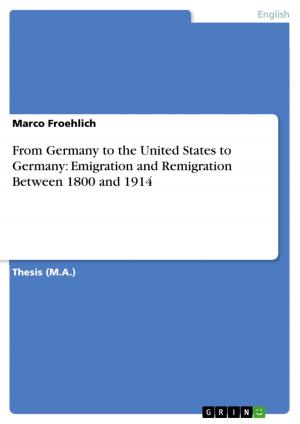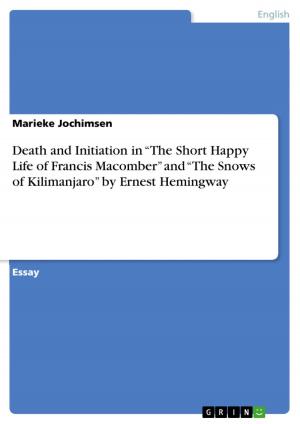J.R.R. Tolkien's Gandalf and Saruman in the tradition of Shakespeare's Prospero
Fiction & Literature, Literary Theory & Criticism, British| Author: | Christoph Höbel | ISBN: | 9783640531639 |
| Publisher: | GRIN Publishing | Publication: | February 9, 2010 |
| Imprint: | GRIN Publishing | Language: | English |
| Author: | Christoph Höbel |
| ISBN: | 9783640531639 |
| Publisher: | GRIN Publishing |
| Publication: | February 9, 2010 |
| Imprint: | GRIN Publishing |
| Language: | English |
Seminar paper from the year 2005 in the subject English Language and Literature Studies - Literature, grade: 2,7, University of Trier (Fachbereich II Anglistik), course: The Tempest and Its Followers, language: English, abstract: The figure of the wizard can be considered as one of the most interesting characters in modern fantasy literature. Normally, wizards are seen as old, wise men, with long beards, robes and staffs who have great knowledge about the world and its history due to long studies and books. However, there are a few ancestors of the wizard as he is seen today: in Arthurian legends you can find Merlin and in Shakespeare's plays Prospero is the great wizard. In creating Prospero Shakespeare conjured an image of the wizard, traces of which can still be found in modern literary figures. As Prospero can be seen as 'providing one of the basic templates for the figure of the wizard' it is interesting to the similarities between wizards like him and wizards in modern fiction. In the novel The Lord of the Rings J.R.R. Tolkien describes two wizards who settled the image of the modern wizard in the reader's mind: Gandalf and Saruman. As 'Gandalf became a cult figure in the late 1960s' his opponent Saruman cannot reach his popularity. However, the two wizards show the two sides of magic between which a wizard can choose: good versus evil. In the novel the wizard plays 'a crucial, super-heroic role' and thus the wizard is manifested as a basic of fantasy literature. Taking into account that Prospero's character has good and bad attitudes in Shakespeare's The Tempest it is interesting to examine the relationship between him and his descendants Gandalf and Saruman as the embodiments of good and evil. Three main aspects will be analysed: the sources of the three wizards' magic, where their power is situated; how to evaluate the use of magic, whether it is good or bad; and in which way the magic is manifested in the outer world. Some abstractions should be considered in analysing Prospero, Gandalf and Saruman: Gandalf and Saruman are known by many names; however, I use Gandalf and Saruman as the most famous and most used names, too. Moreover, the three wizards represent one prototype of wizard: the one who is educated and who uses magical powers. However, in today's fiction there still exist other kinds of wizards who draw their power from other sources, for example, the Wizard of Oz who 'is a charlatan who has arrived in the magical country of Oz by balloon'.
2002-2009 Studium der Germanistik, Philosophie, Anglistik (Universität Trier) 2005-2006 Fremdsprachenassistent in England 2009-2012 Schuldienst 2012-heute Promotion in Philosophie (Antike politische Philosophie, Rhetorik)
Seminar paper from the year 2005 in the subject English Language and Literature Studies - Literature, grade: 2,7, University of Trier (Fachbereich II Anglistik), course: The Tempest and Its Followers, language: English, abstract: The figure of the wizard can be considered as one of the most interesting characters in modern fantasy literature. Normally, wizards are seen as old, wise men, with long beards, robes and staffs who have great knowledge about the world and its history due to long studies and books. However, there are a few ancestors of the wizard as he is seen today: in Arthurian legends you can find Merlin and in Shakespeare's plays Prospero is the great wizard. In creating Prospero Shakespeare conjured an image of the wizard, traces of which can still be found in modern literary figures. As Prospero can be seen as 'providing one of the basic templates for the figure of the wizard' it is interesting to the similarities between wizards like him and wizards in modern fiction. In the novel The Lord of the Rings J.R.R. Tolkien describes two wizards who settled the image of the modern wizard in the reader's mind: Gandalf and Saruman. As 'Gandalf became a cult figure in the late 1960s' his opponent Saruman cannot reach his popularity. However, the two wizards show the two sides of magic between which a wizard can choose: good versus evil. In the novel the wizard plays 'a crucial, super-heroic role' and thus the wizard is manifested as a basic of fantasy literature. Taking into account that Prospero's character has good and bad attitudes in Shakespeare's The Tempest it is interesting to examine the relationship between him and his descendants Gandalf and Saruman as the embodiments of good and evil. Three main aspects will be analysed: the sources of the three wizards' magic, where their power is situated; how to evaluate the use of magic, whether it is good or bad; and in which way the magic is manifested in the outer world. Some abstractions should be considered in analysing Prospero, Gandalf and Saruman: Gandalf and Saruman are known by many names; however, I use Gandalf and Saruman as the most famous and most used names, too. Moreover, the three wizards represent one prototype of wizard: the one who is educated and who uses magical powers. However, in today's fiction there still exist other kinds of wizards who draw their power from other sources, for example, the Wizard of Oz who 'is a charlatan who has arrived in the magical country of Oz by balloon'.
2002-2009 Studium der Germanistik, Philosophie, Anglistik (Universität Trier) 2005-2006 Fremdsprachenassistent in England 2009-2012 Schuldienst 2012-heute Promotion in Philosophie (Antike politische Philosophie, Rhetorik)
